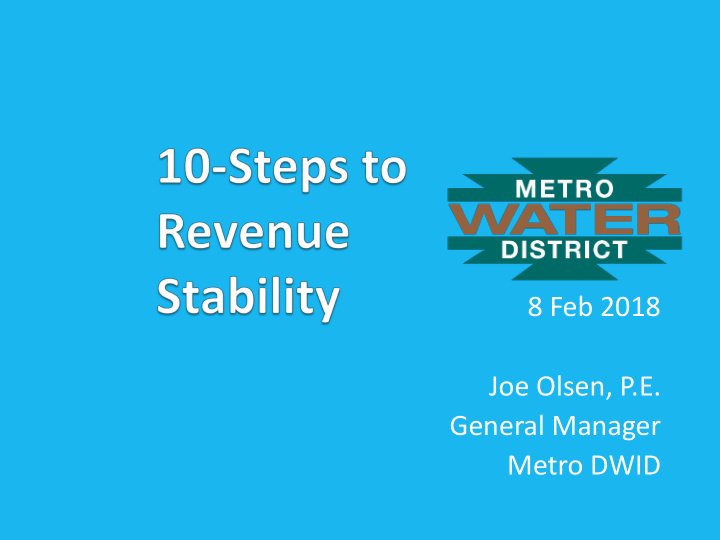



8 Feb 2018 Joe Olsen, P.E. General Manager Metro DWID
Resources vs. Requirements RATEPAYERS CIP Water Resources Debt Service < RESOURCES REQUIREMENTS (Personnel and financial)
Roadmap Revenue stability your customers can comprehend Metro’s multi -year revenue stability journey Expectations and results 10-Step process Revenue Rate Stability Hearing Engage Public Board Support Advisory Comm. Staff Buy-in
Fixed/variable costs? Fixed Costs = Expenses that must be paid regardless of the amount of water delivered to our customers Variable Costs = Expenses that fluctuate with how much water is used Power to Deliver Water = Variable Cost Fixed Cost = Water Infrastructure
Fixed/variable revenue? Fixed Revenue = Water Availability Rate Variable Revenue = Water Consumption Charges (amount paid for water used) Water Consumption Charges Water Availability Rate
Revenue Stability A balance of fixed/variable revenue to meet fixed/variable costs in order to ensure delivery of safe, reliable water Without revenue stability, changes in customer demand add financial uncertainty
Two-Step Revenue Stability Plan Goals included all of the following: Achieve revenue stability Phased implementation of base rate adjustment Restructuring use tiers w/ minimal customer impact Ensure conservation message maintained Buy-in and support across the spectrum
Metro’s Fixed Costs Captured by Base Rate in FY15 (Year 0) 69%
Step 1: Reduce Variable Rate Increase Base Rate Water Availability Rate $22.00 $27.00 Water Consumption Charges 1 st Tier (0 – 4,000 gal) $2.00 99¢ 2 nd Tier (4,001 – 11,000 gal) $2.70 $2.66 Small adjustments to Tiers 3-5
Impact to the Average Customer Avg. Monthly Usage: 8,000 gallons Cost for 8,000 gallons: $40.80 $41.60 Cost Increase per Month: 80¢ (2%)
Metro’s Revenue Stability; FY16 (Year 1) More Fixed Costs covered by Water Availability Rate 83% 69%
Revenue Stability Results Customer demand 3.5% (FY 2016) Revenue for fixed costs 1.1% 0.6% With 69% revenue stability 83% 83% 69%
Step 2: Incorporate 1 st Tier within Base Rate Water Availability Rate $27.00 $29.50 (includes first 3,000 gallons) Water Consumption Charges 1 st Tier (0 – 3,000 gallons) $2.97 0¢ 2 nd Tier (3,001 – 10,000 gallons) $2.66 $2.75 Slight adjustments to upper Tiers
Impact to the Average Customer Avg. Monthly Usage: 8,000 gallons Cost for 8,000 gallons: $44.80 $46.45 = $1.65 (3.7%) Not including adjustment for Water Resource Utilization Fee (10 cents/1000 gal)
Year 2: (FY17) 90% 83% Balancing fixed and variable revenue improves revenue stability, affordability, and the conservation message. Revenue from fixed charges means more financial stability to meet costs. - AWWA Journal, E165
Revenue Stability Results FY 2017 Rate Model Projections Fixed: $9,030,359 (53.0%) Variable: $8,029,165 (47.0%) Total: $17,059,524 FY 2017 Audited Actuals Fixed: $9,109,569 (52.9%) Variable: $8,065,167 (47.1%) Total: $17,263,784
FY 2017 Revenue Stability Results Model accurately predicted results Actual fixed/variable revenue ratio w/i 0.1% Actual revenue was w/i 0.6% of model with $114,000 additional revenue than projected
Step 1 Build Trust and Confidence Transparent expenditures (priority driven process) Keep promises on projections and sun-setting fees Proactive messaging; not just damage control …to keep the promise to customers…. As promised, we are very pleased to report the fee will end…
Step 2 Determine Vision and End-State What level of revenue stability to you seek What is realistic given your organization Decide based on the unique realities you face Try to envision obstacles/hurdles; plan to overcome
Step 3 Crunch the Numbers Leverage rate models and revenue projections to refine possible pathways Internal analysis first if rate consultant will be utilized Let your data drive how you will reach your end-state
Step 4 Gain Staff Support; Validate Share model and results with staff Ensure staff support the effort, adjust based on input Let their passion help drive the initiative Designed by Jcomp - Freepik.com
Step 5 Advisory Committee Ownership “Community Experts,” incorporate refinements Now becomes Committees Plan that staff supports Designed by Jcomp - Freepik.com
Step 6 Educate “ Electeds ” One-on-One discussions to provide background Share Advisory committee perspective Study Session to get vector check
Step 7 Conservation Message Feedback: • Rates still send strong conservation message • Avoids customer rate shock • Increases financial stability of the utility
Step 8 Educate Public Extensive outreach Newsletters, inserts, social media Information Meetings Give a detailed overview 1st Ensure Advisory committee speaks in support of the plan
Step 9 Rate Hearing Formal presentation, address previous concerns Advisory Committee discussion Stakeholder (conservation) perspective Previous steps give “ Electeds ” cover to support
Step 10 Follow-up Follow-up on actual results with customers Further validating and building support (Step 1)
Final Thoughts Don’t fear the base rate Revenue stability is not a competition The longer you wait, the tougher to achieve
Recommend
More recommend